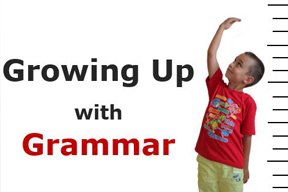Grammar in the Primary School

Things to remember when teaching grammar in the primary school:
- When learning their second language, kids apply the same strategies which they used for learning their mother tongue. Their expectations are:
- The language is always in a situation (has direct relation to a child and his needs).
- The language has purpose (it’s about NOW and HERE).
- Two main approaches to presenting grammar nowadays are: Deductive (Form-Meaning-Use) and Inductive (Meaning-Form-Use). We need to match the way we teach with the way children learn. The inductive approach is more natural and is used by most authentic books.
- 1st class: Implicit Grammar Teaching (Meaning & Use only!)
Students at this age don’t need to understand grammar – they need to use it. You can highlight a lot of grammar implicitly without using grammatical terminology, simply by giving patterns and structures that children can play with and appropriate for themselves. Grammar is incorporated into other activities (games, listening and speaking activities).
The meaning of the grammar structure is introduced in a context (situations that are related to kids’ lives) - stories, pictures, children’s life experience.
After children are exposed to the target language, they need opportunities to use English to communicate with others.
Further recycling of the grammar structure during the course is very important.
- 2nd class: Introducing the rule (Meaning-Form-Use)
Stages of Grammar Presentation:
New Grammar is introduced through familiar vocabulary. Kids want security.
1. Meaning: context (story)
2. It is the teacher’s responsibility to attract children’s attention to language forms and make them aware of accurate language use both orally and in writing.
3. Students study the rule in the book – by this time they must be familiar with the form.
4. Lots of practice (both oral and written use).
- Avoid making learning the grammar terms the focus – the purpose is to learn about how language works!
- Teaching Grammar is always integrated with teaching vocabulary and skills!
- Remember about the value of grammar games: make your grammar lessons more fun!
Primary school Grammar games
Labels
Give each student a label (a piece of paper) and ask them to draw an item from the topic you want to revise (classroom objects). Collect the items and stick or fix one on each pupil’s back. Pupils can’t see what is on their back. The aim of the game is for students to guess the object by asking questions (Is it a book?) Students mingle and ask and answer questions.
Yellow bananas
Prepare an envelope/ a box which you decorate with yellow bananas.
Place some flashcards in an envelope. Ask students to pass the envelope as they listen to a song. Stop the song and ask the student who is holding the “yellow bananas” to take out one of the pictures. Ask the pupil to produce simple sentences (It’s a chair. It’s red/ I’ve got a…)
Basketball
Divide the class into teams. Show a pupil from team 1 a flashcard. If he correctly states the content of the card (a simple sentence), he is allowed to shoot at a specific target (a bin or a box) with a ball of paper. If the ball enters the target, he is awarded 2 points. If the ball hits the target without going in, he is awarded 1 point.
Who’s got it? / Have got
Invite several students to the board and give them a different flashcard each. Students hold their flashcards up to show the class. Ask Who’s got the (cat)? Students answer ...’s got the cat. Students have to say the name of the pupil who has that flashcard.
Crazy Dictation/Present Continuous
Dictate silly/funny sentences (e.g. The horse is dancing on the tree.) Students draw pictures. Students then reproduce sentences from their pictures.
Clothes line
Students put the words in the correct order to make a sentence.
Board race
Draw a large race track on the board. Divide the class into two teams. Use small coloured circles to stick on the board as markers for each team. Ask questions (What’s this? How many?....) Pupils move ahead one space if they say a correct sentence. The winning team are the ones to reach the finish first.
Yes or No?
Use objects or flashcards – different sizes and colours. Choose one of the items and students will have to guess it by asking questions. You can only say YES or NO.
